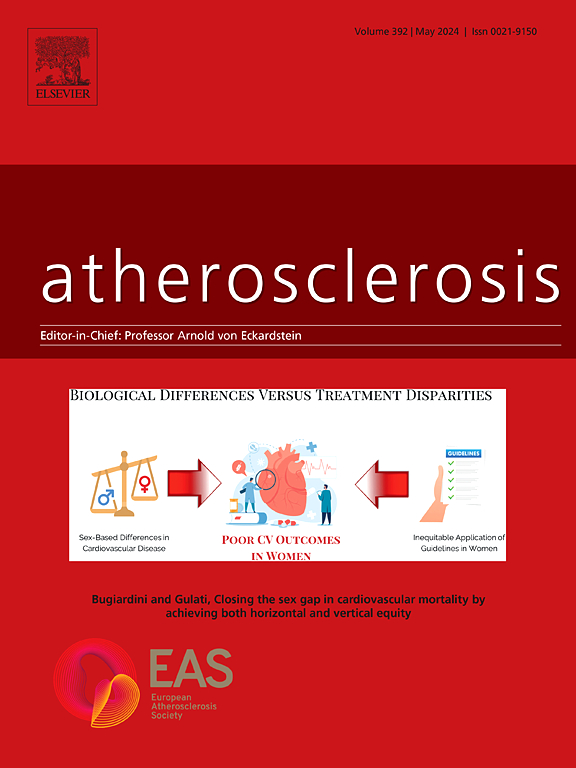Lipoprotein(a) concentrations and secondary outcomes following first-time acute coronary syndrome: The Multi-Ethnic New Zealand Study of Acute Coronary Syndromes (MENZACS)
IF 5.7
2区 医学
Q1 CARDIAC & CARDIOVASCULAR SYSTEMS
引用次数: 0
Abstract
Background and aims
Lipoprotein(a) (Lp[a]) is an established predictor of cardiovascular risk but associations with secondary events are less certain, and data on understudied ethnic groups are scarce. This study aimed to assess the association between Lp(a) and secondary events and explore variation in Lp(a) levels by ethnicity in first-time acute coronary syndrome (ACS) patients, to inform future risk prediction models.
Methods
The Multi-Ethnic New Zealand Study of Acute Coronary Syndromes (MENZACS) is a longitudinal multi-centre cohort study of 1900 patients enrolled during their ACS admission. Baseline plasma Lp(a) concentrations were measured using an isoform-insensitive assay measured in nmol/L. The primary outcome was a composite of all-cause mortality or cardiovascular readmission, ascertained through national health datasets. Cox regression models were used to assess the association between Lp(a) levels and outcomes, adjusted for clinical risk factors.
Results
The mean age was 61 years, 20 % were female, and 73 % were European, 14 % Māori, 5 % Pacific peoples, 4 % Indian and 3 % other ethnicities. Of 1890 alive at discharge, 493 (26 %) experienced the primary outcome over a median follow-up of 4.9 years. Higher Lp(a) levels were associated with increased risk of secondary events. Compared to the lowest quartile (≤7 nmol/L), the adjusted hazard ratio for the highest quartile (>92 nmol/L) was 1.46 (95 %CI 1.12–1.89, p = 0.004). In this ACS cohort, Lp(a) concentrations varied by ethnicity, being highest amongst Indian participants (median 27 nmol/L) and lowest amongst Māori participants (median 12 nmol/L).
Conclusions
Elevated Lp(a) concentrations are associated with secondary events following ACS. Further research is needed to define optimal thresholds for increased risk and explore ethnic-specific implications for secondary prevention.

脂蛋白(a)浓度和首次急性冠状动脉综合征后的次要结局:新西兰急性冠状动脉综合征(MENZACS)的多民族研究。
背景和目的:脂蛋白(a) (Lp[a])是心血管风险的既定预测因子,但与继发性事件的关联不太确定,而且关于未充分研究的种族群体的数据很少。本研究旨在评估Lp(a)与继发性事件之间的关系,并探讨首次急性冠脉综合征(ACS)患者Lp(a)水平的种族差异,为未来的风险预测模型提供信息。方法:新西兰急性冠状动脉综合征多民族研究(MENZACS)是一项纵向多中心队列研究,纳入1900例急性冠状动脉综合征入院期间的患者。基线血浆Lp(a)浓度采用以nmol/L为单位的异构体不敏感测定法测定。主要结局是通过国家健康数据集确定的全因死亡率或心血管再入院的综合结果。采用Cox回归模型评估Lp(a)水平与预后之间的关系,并根据临床危险因素进行调整。结果:平均年龄61岁,20%为女性,73%为欧洲人,14%为Māori, 5%为太平洋人,4%为印第安人,3%为其他种族。在出院时存活的1890名患者中,493名(26%)经历了中位随访4.9年的主要结局。较高的Lp(a)水平与继发性事件的风险增加相关。与最低四分位数(≤7 nmol/L)相比,最高四分位数(≤92 nmol/L)的校正风险比为1.46 (95% CI 1.12-1.89, p = 0.004)。在ACS队列中,Lp(a)浓度因种族而异,印度参与者中Lp(a)浓度最高(中位数27 nmol/L), Māori参与者中Lp(a)浓度最低(中位数12 nmol/L)。结论:Lp(a)浓度升高与ACS后的继发性事件相关。需要进一步的研究来确定风险增加的最佳阈值,并探讨对二级预防的种族特异性影响。
本文章由计算机程序翻译,如有差异,请以英文原文为准。
求助全文
约1分钟内获得全文
求助全文
来源期刊

Atherosclerosis
医学-外周血管病
CiteScore
9.80
自引率
3.80%
发文量
1269
审稿时长
36 days
期刊介绍:
Atherosclerosis has an open access mirror journal Atherosclerosis: X, sharing the same aims and scope, editorial team, submission system and rigorous peer review.
Atherosclerosis brings together, from all sources, papers concerned with investigation on atherosclerosis, its risk factors and clinical manifestations. Atherosclerosis covers basic and translational, clinical and population research approaches to arterial and vascular biology and disease, as well as their risk factors including: disturbances of lipid and lipoprotein metabolism, diabetes and hypertension, thrombosis, and inflammation. The Editors are interested in original or review papers dealing with the pathogenesis, environmental, genetic and epigenetic basis, diagnosis or treatment of atherosclerosis and related diseases as well as their risk factors.
 求助内容:
求助内容: 应助结果提醒方式:
应助结果提醒方式:


